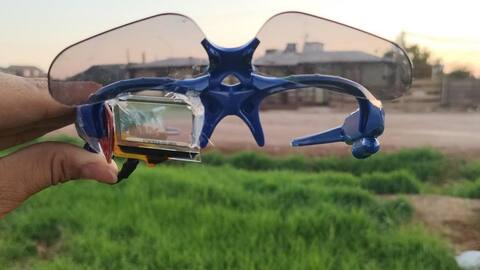Teenager makes functional smart glasses at home: Here's how
What's the story
In a major surprise, a 16-year-old teenager from Arizona, US has created a pair of smart glasses right at home.
Mars Kapadia claims that his device is the "world's first pair of TOLED (Transparent Organic Light Emitting Diode) smart glasses" and can nearly replace a smartphone at performing day-to-day tasks like checking notifications and news, among other things.
Here's more about his DIY project.
Project
Smart glasses for school project, inspired by Tony Stark's tech
After building some very interesting school projects, Kapadia began the daunting task of building a pair of smart glasses.
The teenager was very much inspired by Tony Stark's EDITH glasses in The Avengers and wanted to create something similar for himself.
So, in 2019, he submitted the glasses as an entry for a school fair and has been perfecting that design ever since.
Quote
'All-in-one glasses that could literally do everything'
"I never really saw a concept that was very intriguing until I saw The Avengers. That's when I saw the all-in-one glasses that could literally do everything...I knew I had to...try and build it into one well-functioning, very advanced product," Kapadia told Popular Mechanics.
Development
How did he build it?
To bring the glasses to life, Kapadia used a pre-fabricated screen and a transparent display from SparkFun Electronics and attached both to the plastic body of a pair of blue shades.
On top of that, the young inventor placed two tinted lenses that could flip up and down manually and let him see the display and the real world at any time of day.
Working
Arduino Nano Every under the hood
Post setting up the display and lenses, connected using a custom-built hinge, Kapadia got the whole rig up and running by hooking it to a cheap Arduino Nano Every microprocessor, lithium-polymer battery, and a Bluetooth module that paired the glasses to a companion app he had built.
Overall, he said, the entire project cost him about $200.
Functioning
Effective functioning in testing
Since creating the smart glasses, the teenager has been testing it while jogging, working, and performing other tasks.
"They replace smartwatch and almost replace my phone. So now I'm able to keep the phone in my pocket as I'm running, to see if I got a text or a call from my mom, or even if I wanted to see the news," Kapadia said.
Opportunity
Opportunity for construction workers, doctors
Kapadia thinks that his device, if advanced, could be very useful in showing doctors or construction workers detailed instructions as they work on their projects.
For now, he plans to patent this design and also grow his YouTube Channel to create more such interesting devices.
And in the long run, he also wants to establish a company geared towards creating AI-powered biomedical devices.
